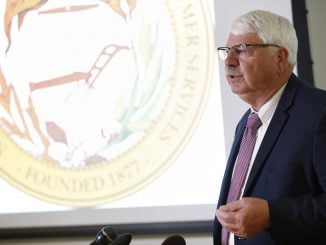RALEIGH — The N.C. Department of Public Instruction disagreed on key points with an audit criticizing how the agency spent CARES Act funds and criticized the State Board of Education for lack of accountability.
DPI’s response letter, penned by Superintendent Mark Johnson, disagreed with two out of the three findings contained in the N.C. State Auditor’s Office (NCNCSAO) audit report.
The audit claims the Department of Public Instruction distributed $31 million of Coronavirus Relief Funds for the Summer Learning Program without a method to ensure student ability was improved, $37 million of Coronavirus Relief Funds for nutrition services without establishing a method to measure results, and $76 million of Coronavirus Relief Funds without a method to detect misuse of the funds.
State Auditor Beth Wood also published a video report in which she summarized the NCASAO’s position and three main findings.
Johnson agreed with the first finding, which said the Summer Learning Program was “without a method to ensure student ability was improved,” but said the State Board of Education is at fault for that lack of accountability.
“DPI agrees with the finding and the recommendation, but unfortunately, the tool to measure student ability was terminated by the NC Board of Education,” writes Johnson. “Any effort to measure the impact now simply cannot be made based on quantifiable, verifiable information.
Johnson also noted the state board did not put a new tool in place, and writes, “when pressed for a reason why the State Board would not continue, members responded that they believed teachers already had enough data on students and that the State Board felt the benefits of this tool did not merit funding.”
From the lengthy description given by Johnson in the response, it seems likely he might be referencing Istation, making mention that “leadership of the State Board seemed to enjoy a close relationship with one of the primary competitors of the vendor who supplied the diagnostic tool.” Johnson goes on to detail how board member J.B. Buxton and the CEO of a rival vendor had phone conversations that ended with Buxton’s “successful effort to end the contract.”
Then in the section on the Summer Learning Program, Johnson also claims that the representative from the department made incorrect statements to the OSA. He also wrote that the department will be following up with the OSA to correct the record.
In his response, Johnson indicates that they will have data on how many students attended the summer program and that eligibility and participation data is required for a report due by Feb. 15, 2021, to the legislature’s Joint Legislative Education Oversight Committee.
Johnson’s letter disagreed with the two other findings of the OSA’s audit. Those two other findings are that $37 million of Coronavirus Relief Funds were distributed for nutrition services without establishing a method to measure results and that the department distributed approximately $76 million to public school units (PSU’s) but did not monitor that spending.
In terms of tracking relief funds used for nutrition services, DPI’s lengthy response details that the funds were indeed tracked but that the full results won’t be compiled until the end of December.
“To date, four of the five oversight objectives have been achieved and desk audits are underway to examine the allowable use of funds and to assess and document PSU implementation strategies,” says Johnson’s letter. The letter also notes “the School Nutrition Division has not only had a plan to monitor the use of these funds, the plan is currently being implemented among sub-recipients.”
DPI’s response goes on to explain that Gov. Roy Cooper’s executive order closing all schools created issues with children being able to have access to food. That resulted in the School Nutrition Division implementing a “state-wide emergency meal distribution operations to prevent a secondary public health nutrition crisis among food-insecure children,” which included all children ages 18 and under.
“In other words, DPI used the federal money to feed children during the pandemic regardless of whether or not they were a student at a particular school,” Johnson summarized.
School meals provided through the National School Lunch Program during the instructional day are a primary source of food and nutrition for nearly 60% of students enrolled in North Carolina’s public schools.
The additional food being supplied strained funding, which DPI explains was unsustainable and requested further funding aid from the General Assembly. As a result, the NCGA appropriated $75 million in Coronavirus Relief Funds to support nutrition services for children throughout the state
Johnson’s response letter also criticized OSA’s inclusion of “aspirational statements” as a valid way to assess the SND’s performance in monitoring the spending of the funds. An example is OSA’s statement, “All of the children who needed to receive meals actually received them.”
Johnson counters that statement by saying, “there is no reasonable strategy to measure this outcome during the emergency public health response since children receiving meals are not specifically identified. Again, children were not specifically identified so that any child who showed up in need of food would be able to eat.”
As with an earlier section of its response, Johnson writes of the finding regarding the $76 million given to PSU’s that OSA has received incorrect information. Specifically, Johnson mentions “the statement related to the vacancy as cause for a delay in monitoring efforts is false. Also, the statement about moving the entire section is unrelated to the finding.”
Not mentioned in the OSA audit is that according to the U.S. Dept. of Education, North Carolina has only spent 48% of the over $953 million in Federal Education Stabilization Funds, with NCDPI spending only 20.5% of the over $396 million in Elementary and Secondary Education Relief (ESSER) funds. The ESSER funds must be awarded within one year after the state receives them.


